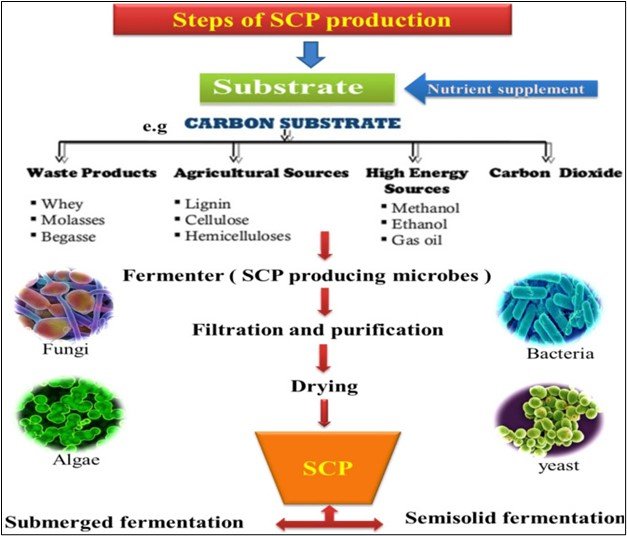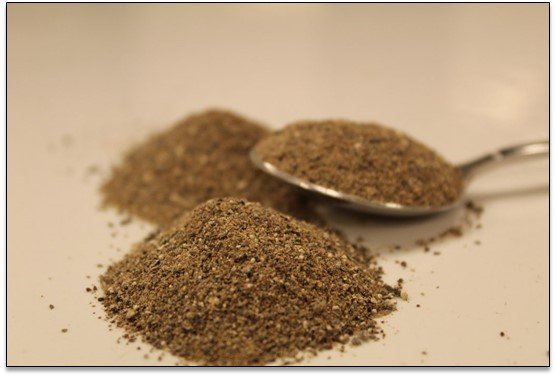The rapidly increasing world population brings about the challenge of providing necessary food sources. Specifically, insufficient protein supply poses a problem since essential amino acids cannot be replaced. Over the last few decades, numerous efforts have been made to explore the alternative option for protein production. In the face of such worldwide issues, Single-Cell Protein (SCP) is derived which are produced from dried cells of bacteria, algae, fungi, yeast. SCP is protein-rich foods that can be used as dietary supplements. Microbial biomass has been considered an alternative to conventional sources of food or feed. Large-scale processes for SCP production show interesting features. With a rise in the human population, the demand for food is also increasing. Under this situation, alternative sources of protein such as SCP have become a growing field of interest.
SCP is crude or refined edible protein originating from different microbial sources such as bacteria, algae, yeast and fungi. SCP is so named as it is derived from single-celled organisms. Fungi, algae, yeast, and bacteria have very high protein content in their biomass. Due to the presence of high-protein content, SCP can be used as a protein supplement for both humans and animals. These unicellular microbes can grow using inexpensive substrates like agricultural wastes. The term 'single-cell protein' was first coined by researchers at the Massachusetts Institute of Technology (MIT) in 1968 and it has been used to describe the production of foods or feedstuffs from unicellular organisms. SCP is a nutrient-rich food containing fats, carbohydrates, nucleic acids, vitamins and minerals, essential amino acids like lysine and methionine. They can grow using conventional substrates such as starch, molasses, fruit and vegetable wastes, as well as unconventional ones such as natural gas, ethanol, methanol and lignocellulosic biomass for SCP production.
Microorganisms Used in SCP Production
Organism choice is critical and highly dependent upon numerous factors. The organism must be demonstrably safe during growth and processing. The novel nature of bacterial processes tends to lead to demands for immense toxicological trials which increase the cost of development by a significant sum. For substrates such as simple carbohydrates, the yeasts Saccharomyces cerevisiae and Candida utilis present attractive choices because they have been used as food ingredients for a long period. Single-cell protein (SCP) or proteins produced from microbial and algal cells, is an option with great potential. SCP is currently produced from specific microorganisms, particularly when it comes to human consumption. The range of sources for SCP approved for human consumption is expanding. Products derived from algae, fungi (including yeast) and bacteria are all in use or under development. Few microorganisms responsible for SCP production are:
• Fungi: Aspergillus niger, Rhizopus cyclopean, Aspergillus fumigatus
• Yeast: Candida utilis, Saccharomyces cerevisiae, Candida tropicalis
• Bacteria: Pseudomonas fluoroscens, Bacillus megaterium, Lactobacillus sp.
• Algae: Chlorella pyrenoidosa, Chondrus crispus, Spirulina sp.
SCP Production
The worldwide, large-scale production of SCP has significantly contributed to the advancement of present-day biotechnology. The pure microbial culture for single-cell protein production needs a good source of nitrogen, sufficient carbohydrates and other nutrients. A highly sterile condition should be maintained in order to prevent the culture from contamination. Production of SCP requires microorganisms that serve as the protein source and the biomass substrate on which it grows. The production is carried out in the following steps:
I. Selection of a suitable strain.
II. Fermentation of the microorganism.
III. Harvesting in proper condition.
IV. Post-harvest treatments.
V. Processing of SCP to make the biomass edible.

Advantages
There has been a misconception in the general population that bacteria and other microorganisms are only the causative agents of diseases but study findings led us to a conclusion that they can be helpful at times beyond their disease-causing ability. Single-cell protein production can be a more sustainable alternative to that of the conventional methods of protein production. The advantages are:
i. Production of SCP requires less land space. SCP are produced in large fermenters, so they require a lot less area than cultivation fields.
ii. Broad spectrum of raw materials can be used including waste products.
iii. Microorganisms have a high growth rate, which means a large quantity of biomass can be produced in a comparatively shorter duration. Yeast is suitable for single-cell protein production because of its superior nutritional quality.
iv. The microbes can be easily genetically modified. Thus, various amino acid compositions can be found.
v. A wide variety of raw materials, including waste materials, can be used as substrates, decreasing the number of pollutants.
vi. Production is independent of climatic conditions.
vii. Improved quantity and quality of SCP.
Drawbacks of SCP Technology
The principal disadvantages are as follows:
i. The small size and low density of bacterial cells make harvesting from the fermented medium difficult and costly.
ii. Bacterial cells have high nucleic acid content which elevates the serum uric acid levels and also causes severe gastrointestinal problems.
iii. Presence of secondary toxic metabolites.
iv. Poor digestibility as the cell wall is present which is non-digestible.
v. High cost of production.
Applications of SCP
I. Protein Supplemented Food
i. Acts as an energy source.
ii. Excellent source of vitamins, amino acids, minerals and other nutrients.
II. Used in Therapeutics for
i. Controlling obesity, cholesterol, stress and lowering blood sugar level in diabetic patients.
III. Used in Cosmetics Products for
i. Production of different herbal beauty products, like- bio lipstick, herbal face cream etc.
IV. Used in Poultry and Dairy Farms
i. As it is rich in proteins and other nutrients, it is widely used for feeding cattle, birds, fishes etc.
SCP presents very attractive features as a nutrient supplement for humans. It is of great nutritional value as it is rich in protein, lipid and vitamin content, and essential amino acids. SCP has various advantages over animal and plant proteins in that its requirement for growth is neither seasonal nor climatic dependent; therefore, it can be produced throughout the year. Moreover, high nucleic acid content, non-digestible cell wall, undesirable colours and flavours and a high risk of contamination further restricts their use as a global food. SCP has the potential to deliver a myriad of products but considerable research and development and particularly scale-up is required. Therefore, further research should be made to find alternative substrates and methods that can minimize the drawbacks of the substrates and methods currently being used for SCP production and thus result in the acceptance of this valuable nutrient supplement globally.

